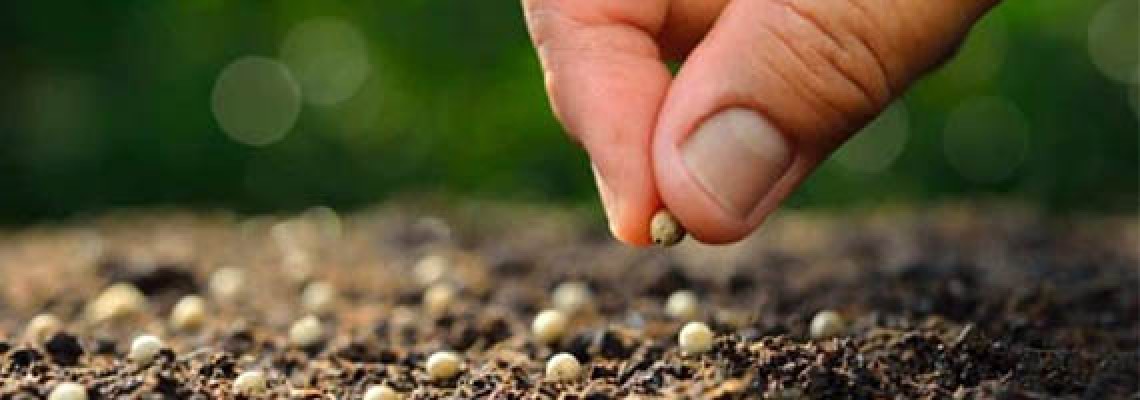*This text is provided for informational purposes only. The information given by the author is his own development using information from publicly available sources. The company is not responsible for the author's material presented.
Content:
How to germinate cannabis seeds
This article is not a guide to action. Errors Seeds sells souvenir cannabis seeds. Germination and cultivation of cannabis can lead to administrative or criminal liability in accordance with the law of Ukraine. Errors Seeds is not responsible for the use of souvenir seeds by customers.
As you already know, it is from the seed that the growth of cannabis begins. This is not a very difficult, but incredibly important process. Your entire subsequent harvest will depend on how you approach its implementation. Due to careless handling, poor conditions, or questionable seed quality, a sprout may die before it sees the light of day. How to plant hemp? Read the article and find out the answer.
Intro
To fully understand the process, a brief excursion into the types of seeds is necessary.
Cannabis seeds are divided into two main types: autoflowering and photoperiodic.
Different in that photoperiods bloom and bloom under the light regime of 12/12 hours of the day / night. Autoflowering bloom and bloom regardless of daylight hours - after 2-4 weeks from germination (this period depends on the characteristics of specific varieties).
"Regular" and "feminized" seeds. In the first case, we are talking about ordinary seeds from which ordinary plants grow - approximately 50/50 male (pokopon) and female (material) cannabis plants. Feminized give exclusively female plants.
We recommend choosing seeds and varieties based on the location where you plan to grow. Photoperiods can be made simply huge - up to several meters. Autoflowers are limited in their growth by the timing of fast flowering. At the same time, if desired, the growth of photoperiods is much easier to regulate.
Indica / sativa
Indica is a type of strain characterized by short stature, wide leaf, fleshy dense flower (cone), fast flowering of 7-9 weeks and a stone-like effect on the psyche - this is what "nails" you to the couch.
Sativa are tall strains with long narrow leaves, long flowering (12-15 weeks), very high yields and many small flowers and a "high" effect - uplifting and energetic.
Hybrids are hybrids of indica and sativa strains. They can carry signs of both.
Tips on how to plant marijuana seeds:
- Store the seeds in an airtight plastic bag or the manufacturer's packaging and take them out only when you decide to plant them. Use medical gloves or tweezers, try not to touch the seeds with your hands. Grease and dirt from fingers can create a fatty shell around the seed, which will lead to its death.
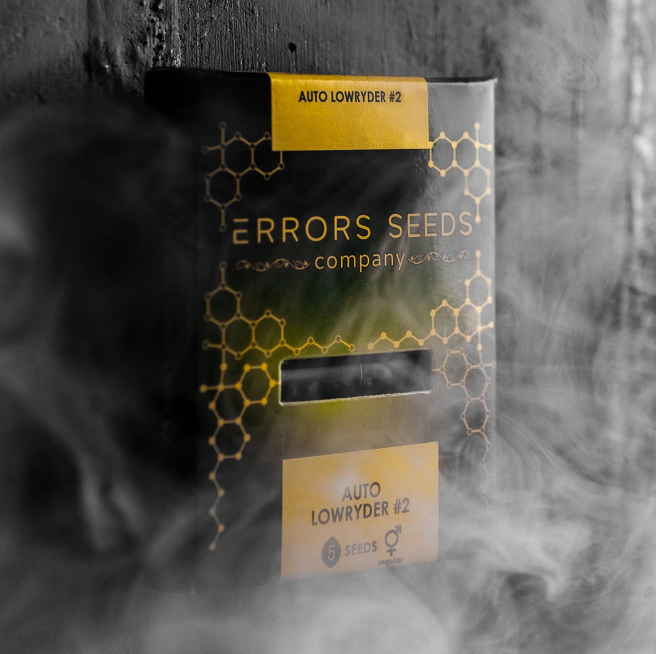
Example of seed-safe packaging
- Separate healthy seeds from weak ones. Viable seeds are dark in color, have a characteristic pattern, are hard to the touch (do not break when lightly squeezed with fingers) and dry. If the seed is too light (hollow inside), white or light green, then it is probably an underdeveloped seed and will not make a healthy plant.
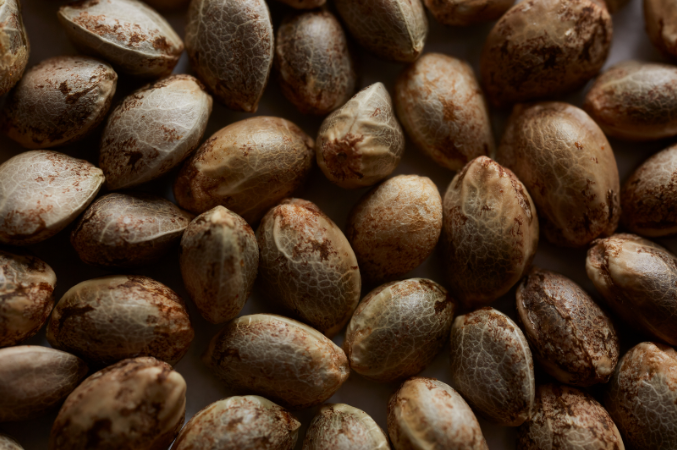
Example of healthy seeds
- Soak the seeds in a glass of clean water at room temperature (20-25°C) for about 12 hours. This is necessary so that water gets through the shell into the seeds and the germination process goes faster.

- Soaking seeds in a glass of water for more than 24 hours will deprive them of oxygen and they will likely drown and not germinate. A seed that sinks after 12 hours is likely to be viable and germinate well. Heat floating seeds periodically. Seeds that do not sink even after 12 hours are unlikely to germinate soon.
- Get a water sprayer and set reminders to spray your paper towel. A dry wipe can damage a newly sprouted taproot and kill plants before work begins. The reverse is also true: too humid environment will not allow the root to germinate, the seed will simply suffocate and drown.
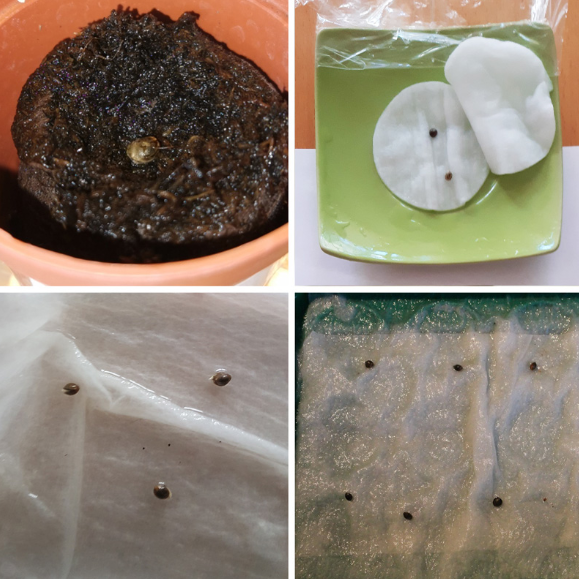
Wetted environment
- Don't forget your germinating seeds! If you leave them too long in a container and don't plant them, they will grow a long taproot but eventually die without proper growing conditions.
Before we get straight into sprouting techniques, there are a couple of golden rules. For best results, we recommend that you follow these guidelines no matter how you choose to germinate. That being said, of all the factors to consider, temperature is one of the most important.
- The ideal temperature is between 22° and 25°C.
- The growing medium should be moist but never wet. Water should not leak from paper towels / gauze / cotton pads.
- The relative humidity range must be between 70% and 90%
How to germinate marijuana seeds at home in 3 easy steps
To germinate seeds you will need:
- Cannabis Seeds
- Plastic container with lid or 2 plates
- Paper towels\ gauze\ cotton pads
- Clean water spray bottle
- Small cup or glass
In order for the first small tap root to appear, the seed needs three conditions: heat, humidity and darkness. Under the right conditions, the seeds will begin to develop within 12-36 hours after receiving moisture.
- Place paper towel/cotton pad/gauze in a plastic container or plate. Moisten it with a spray bottle. The germination medium should be moist, but there should be no excess water. Put the seeds pre-soaked in a glass of water there, at a distance of a couple of cm from each other. Sprinkle a second washcloth with warm water and cover the top of the seeds with it. Cover your container with a lid, or a second plate if using. Place the container in a dark, warm place at 21-25°C and leave it there.
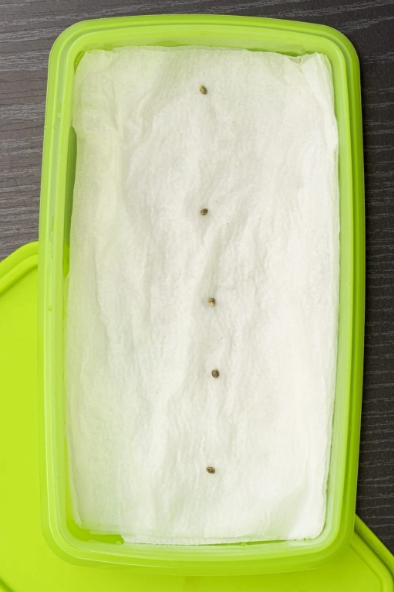
- Open the container every few hours and spray lightly with water until the seeds open. Never let the wipes dry or your seed will not germinate. The napkin should remain damp, but not soak through. Prepare the next growing medium as soon as you see the seeds open.
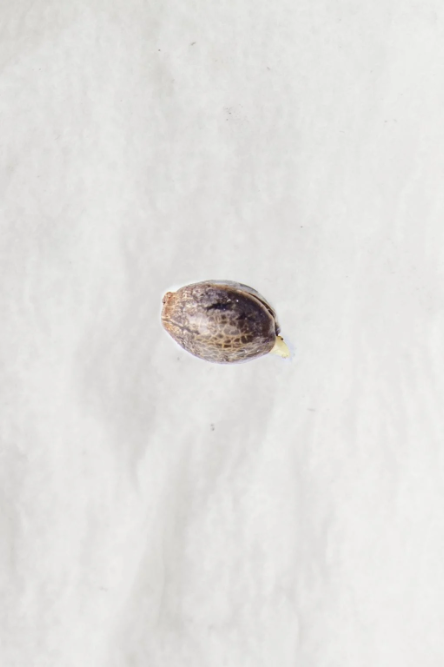
- When the seed has opened and revealed a white taproot, it's time to place it in the next growing medium (soil, coco, peat).
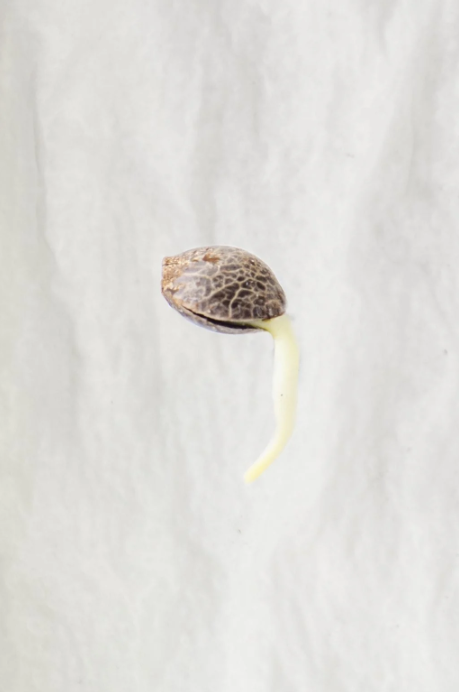
In order to transplant a seed into a permanent growing medium, a root 2-3 mm long is enough. Growing a longer root is dangerous and impractical. When transferring seeds, a long root can easily be damaged.
How to plant cannabis correctly?
Punch a hole in the ground about 10mm deep. This will be the new home for your seed. Carefully remove the seeds from the container and place them in the previously dug holes. Loosely cover the seeds with soil, but be careful not to press the soil over the seeds too much. The root will struggle to penetrate the hard soil, slowing down the growth of the plant. Lightly mist the area where you placed the seeds with a spray bottle to keep the environment moist. That's all, after that it remains only to wait. Nature will surely do its part and soon you will see a small sprout.
Below is a list of varieties for beginners. They are distinguished by increased endurance (forgiving mistakes to novice growers). The best strains for beginners are autoflowering indica hybrids. Due to the Ruderalis gene, they have a better survival rate, and also bloom on their own, about 3-4 weeks after germination.
- Auto Lowryder2 feminised Gold The Lowryder is ideal for beginners. A low, hardy plant will please you with a harvest in the shortest possible time.
- Auto Gagarin Feminised Silver The variety name speaks for itself. Guarantees you flight into the stratosphere. Afghan, Hawaiian and Jamaican genetics provide the perfect combination of aromatics and strength.
- Auto Super Skunk Feminised Gold Indidominate, unpretentious variety. One of the few autoflowering skunks. Grows up to 120 cm in height.
- Auto Blackberry Feminised Silver combined with endurance and unpretentiousness. For beginners who want to try the exotic, be sure to familiarize yourself.
- Auto F*cking Dead Russian Feminised Gold Genetics Ak47*White Widow will delight you with a chic combination of terpenes. Resinous cola will not leave indifferent any grower.
Literature used
- Clarke, R. C., & Merlin, M. D. (2016). Cannabis: Evolution and Ethnobotany. University of California Press. (pp. 83-96)
- Cervantes, J. (2006). Marijuana Horticulture: The Indoor/Outdoor Medical Grower's Bible. Van Patten Publishing. (pp. 189-204)
- McPartland, J. M., Clarke, R. C., & Watson, D. P. (2000). Hemp Diseases and Pests: Management and Biological Control: An Advanced Treatise. CABI Publishing. (pp. 115-130)
- Rosenthal, E. (2017). Marijuana Garden Saver: Handbook for Healthy Plants. Quick American Archives. (pp. 65-78)
- Van Patten, G. (2010). Marijuana Cultivation Reconsidered: The Science and Techniques For Huge Indoor Yields. Van Patten Publishing. (pp. 107-122)
- Cervantes, J. (2007). Marijuana Outdoors: Guerilla Growing. Van Patten Publishing. (pp. 45-58)
- Green, D. (2016). The Cannabis Breeder's Bible: The Definitive Guide to Marijuana Genetics, Cannabis Botany and Creating Strains for the Seed Market. Green Candy Press. (pp. 81-96)
- Jong, T. D. (2005). Marijuana Indoors: Five Easy Gardens. Van Patten Publishing. (pp. 151-164)
- Clarke, R. C. (2013). Hashish!: Updated Second Edition. Red Eye Press. (pp. 89-104)
- Fournier, G., Richez-Dumanois, C., Duvezin, J., Mathieu, J. P., Paris, M., & Pourcelot, Y. (1995). Cannabis sativa L.: Botany and Biotechnology. Springer. (pp. 67-82)
Author: Dmitry Morgan
Related articles:
